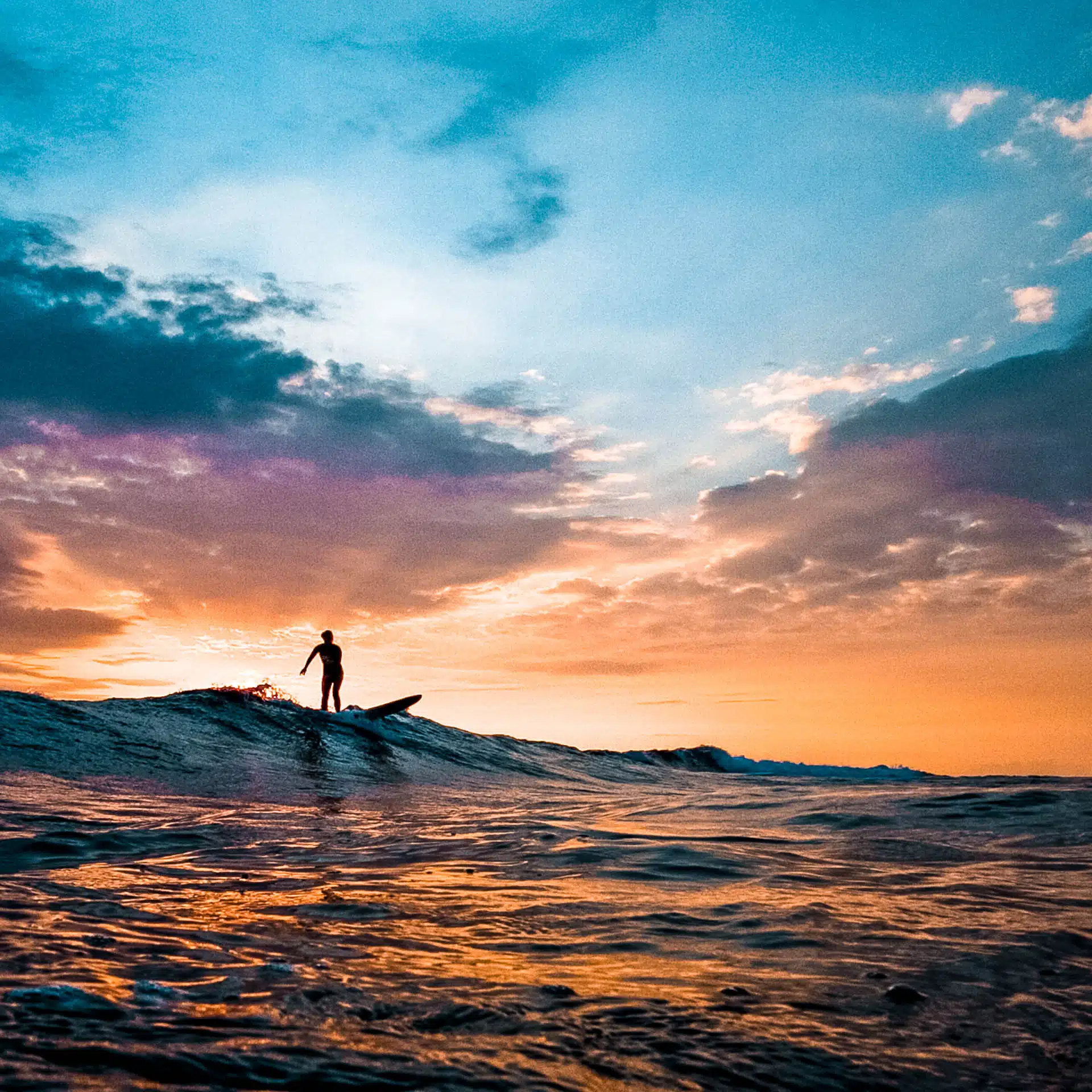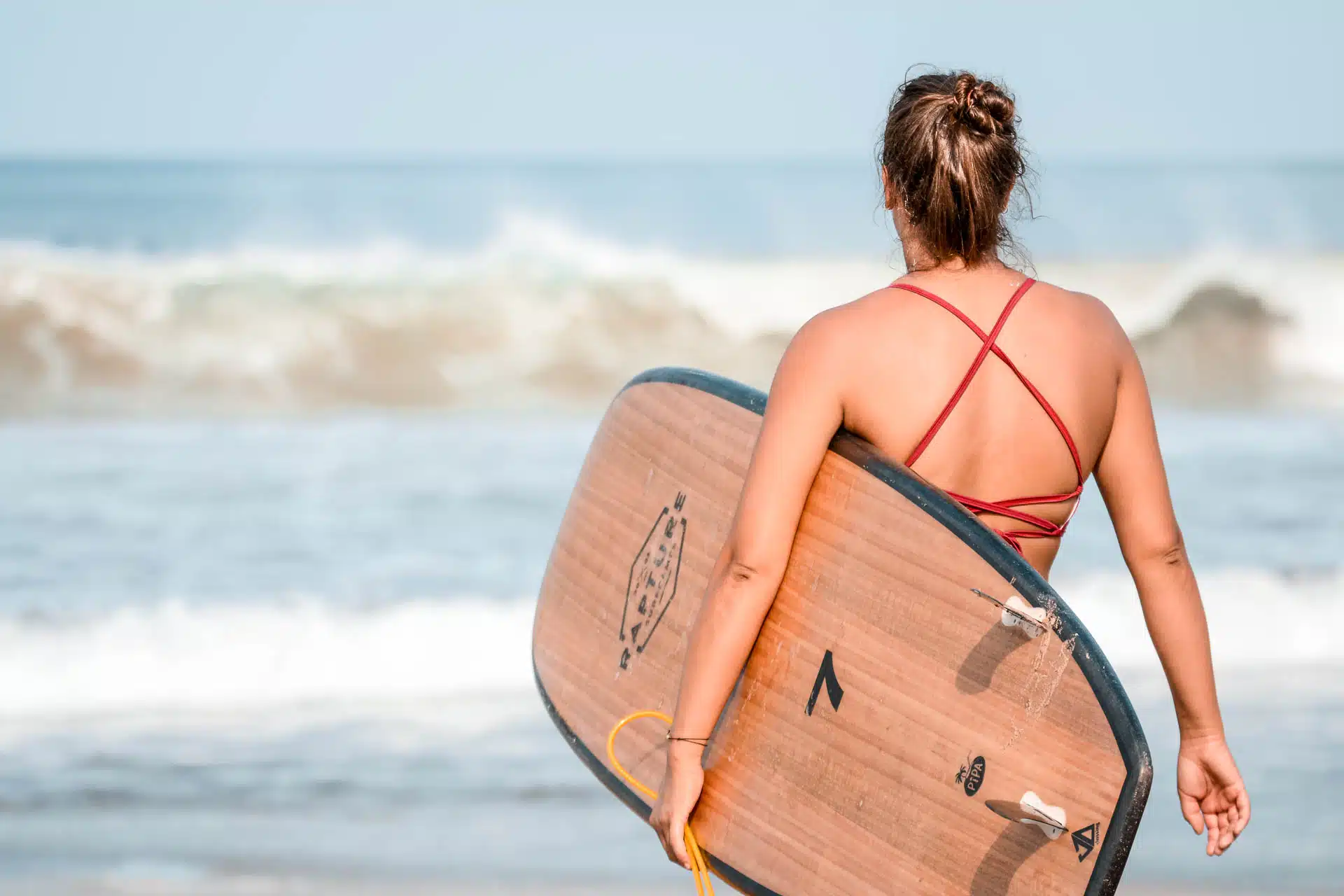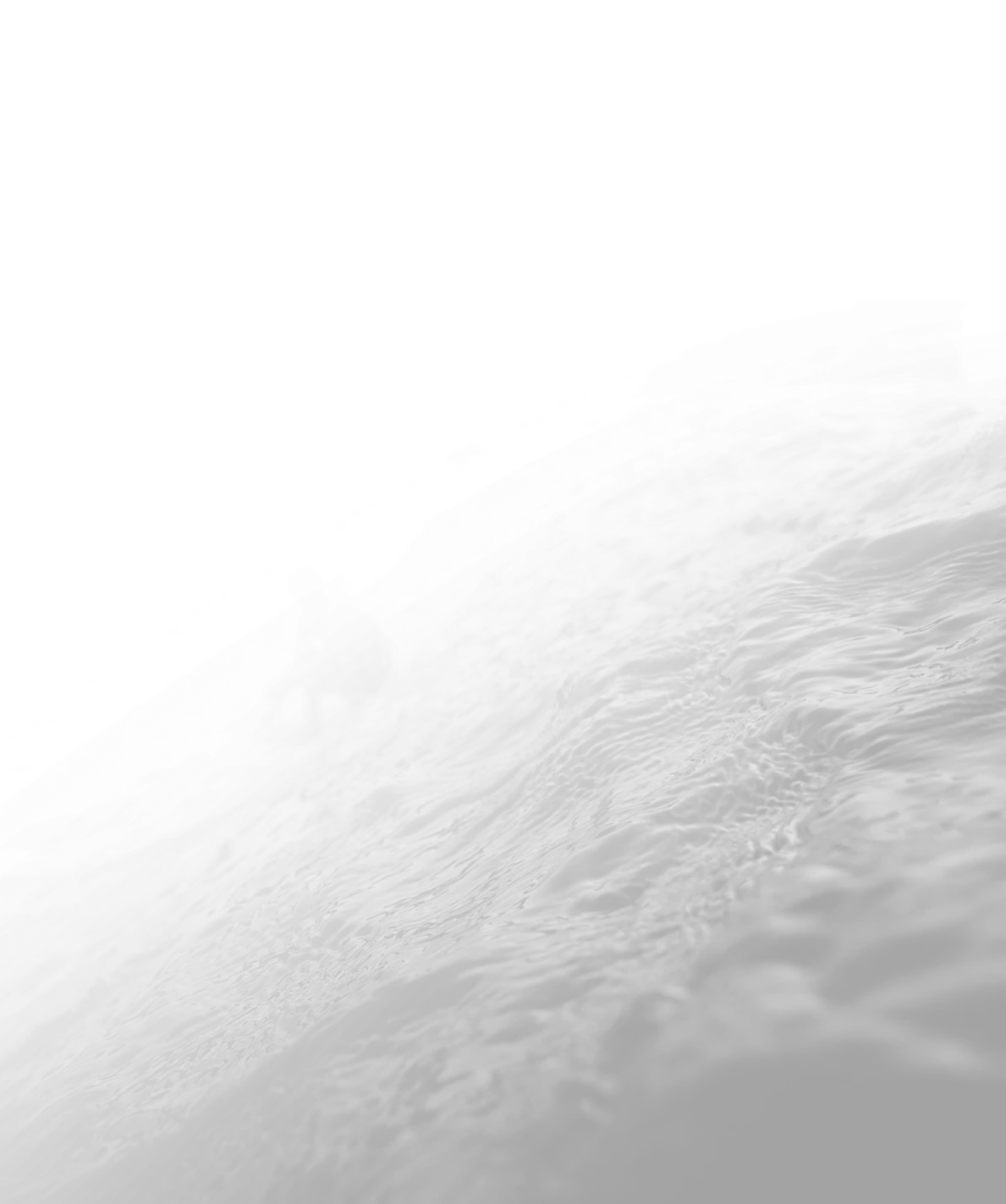To sound like a true surfer, you’ve gotta know the lingo! Here are 47 essential surf terms that’ll help you blend right in the next time you hit the beach. Spoiler alert: “Cowabunga” didn’t make the cut!
Every sport has its own vocabulary. But surfing really is in a league of its own. To an outsider, surf lingo can seem like an entirely different language – and if you’ve ever overheard two seasoned surfers chat about a swell forecast, you’ll know exactly what we’re talking about.
But, speaking like a surfer is easier than you might think—you don’t need years of experience on the waves. A quick look at the list below will give you the basic surf terms you need to follow along with what competitors are saying in those WSL post-heat interviews.
So, with that said, let’s dive into our glossary of surfing terms!
1. Wipeout
Falling off your board while riding a wave? That’s called a wipeout—and trust us, a young surfer wanting to talk like a pro will get very familiar with this term!
2. Leggie
A “leggie” (or leash) is the trusty cord that keeps your surfboard close, connecting your ankle to the board’s tail so it doesn’t drift away after a wipeout. Made of lightweight urethane, leggies come in various sizes—thicker ones for big waves and thinner ones for smaller surf.
3. Pocket
The area of the wave closest to the curl or whitewash is what surfers call the pocket. This part of the wave face is where you should surf to generate the most speed.
Fun fact: Another related surfing term is the “energy zone,” the steepest part of the wave.
4. Thruster
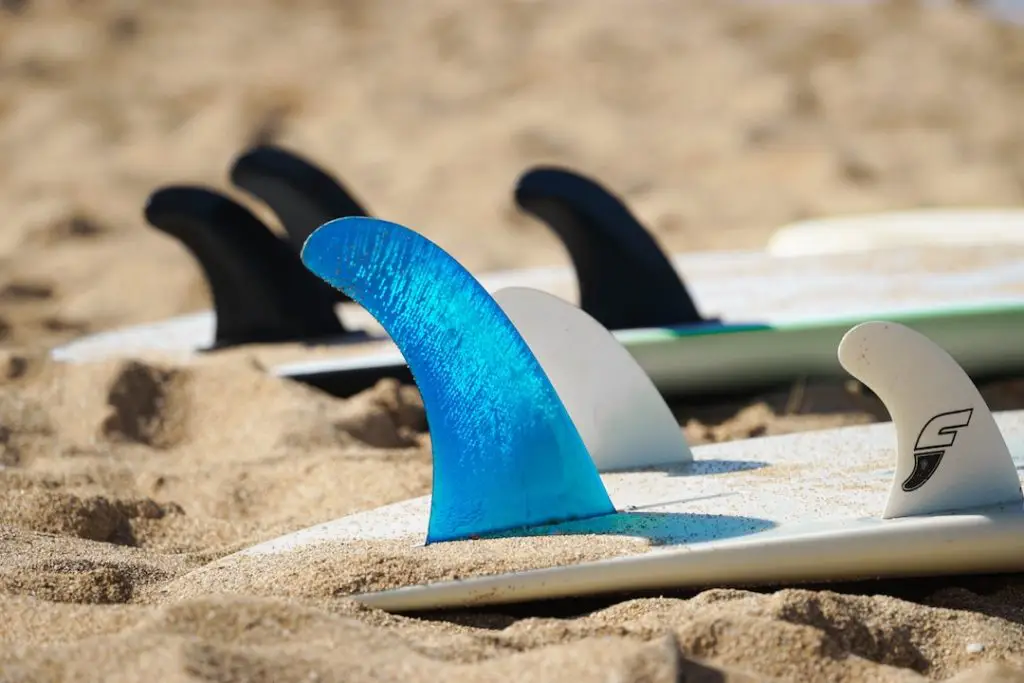
The thruster setup features three equally sized fins on the bottom of a surfboard. This design, pioneered by Australian surfer Simon Anderson in 1980, has become the most popular fin configuration for modern surfboards due to its balance, control, and versatility in various wave conditions.
5. Kook
The term “kook” in surfing doesn’t describe a technique or piece of gear; instead, it refers to a surfer who disrupts or endangers others in the water. Often lacking knowledge of surf etiquette, kooks may be clueless about proper behaviour. However, they’re not always an inexperienced surfer—seasoned surfers can also display “kookism” from time to time.
6. Cutback
A cutback is a classic surfing maneuver. It’s performed by carving the open face of an oncoming wave, using an arcing motion to bring the surfboard back around. This brings you to the point where you can rebound off the whitewash, ideally before the wave breaks.
Since a cutback can even be performed on the flattest part of a wave, it’s a foundational skill for beginners and intermediates.
However, with the right conditions—such as minimal onshore wind, which keeps the wave surface smoother, a well-executed cutback can help you maintain both flow and speed, allowing you to stay in control even on a challenging open ocean wave.
7. Punt/Aerial
A “punt” or an “aerial” is surfer slang that describes the act of propelling your board above the lip and taking it into the air. This is an advanced maneuver that should only be attempted by the very best surfers; it requires lots of speed and a decent ramp from which to launch off… which leads us nicely onto our next surf slang.
8. Ramp
A “ramp” is the launch point for a surfer aiming to perform a punt or aerial maneuver. Typically, this ramp is found at the lip or a steep section on the face of the wave.
9. Onshore/Offshore
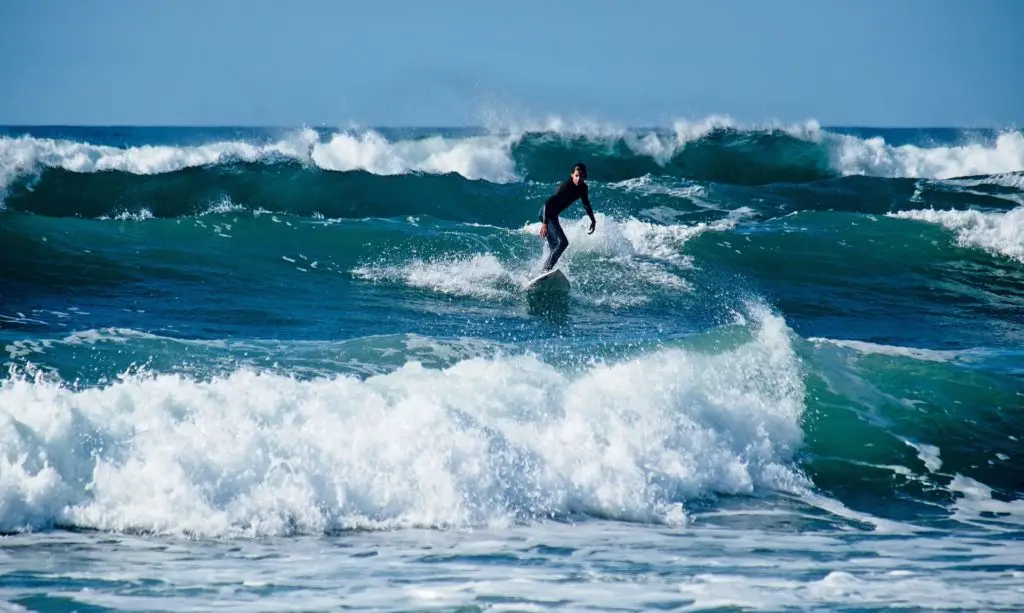
“Onshore” and “offshore” describe the direction of the wind and its impact on wave quality for a particular break.
Onshore winds blow from the ocean toward the shore, often causing the wave lip to crumble and creating surface chop or ribbing that can disrupt the wave’s shape.
In contrast, offshore winds blow from the land out to sea, smoothing the waves and shaping them into cleaner, more rideable forms, ideal for a satisfying surf session.
Planning a Surf Trip? Think Rapture Surfcamps!
10. Going over the Falls
“Going over the falls” describes the wild ride of getting pulled over by a breaking wave, often after pulling back on a takeoff or missing a duck dive. It’s a term that might get a laugh from those watching, but for the surfer, it’s anything but funny!
11. Duck Dive
A duck dive is a key surfing move where you push your board under the water, diving beneath an oncoming wave to avoid getting swept back. Inspired by the way ducks dip underwater when fishing, mastering this technique is essential if you want to surf – and sound – like a pro!
12. Reformer
A “reformer” wave is a type of wave that breaks twice as it moves towards the shore. It first breaks farther out in the water, creating a line of whitewash, but instead of dissipating, it “reforms” and gains shape again as it nears shallower water, breaking a second time closer to shore.
Reformer waves are often ideal for an inexperienced surfer, particularly on longboards, as they tend to be less powerful on the second break and are easier to catch close to the shore.
13. Shorey
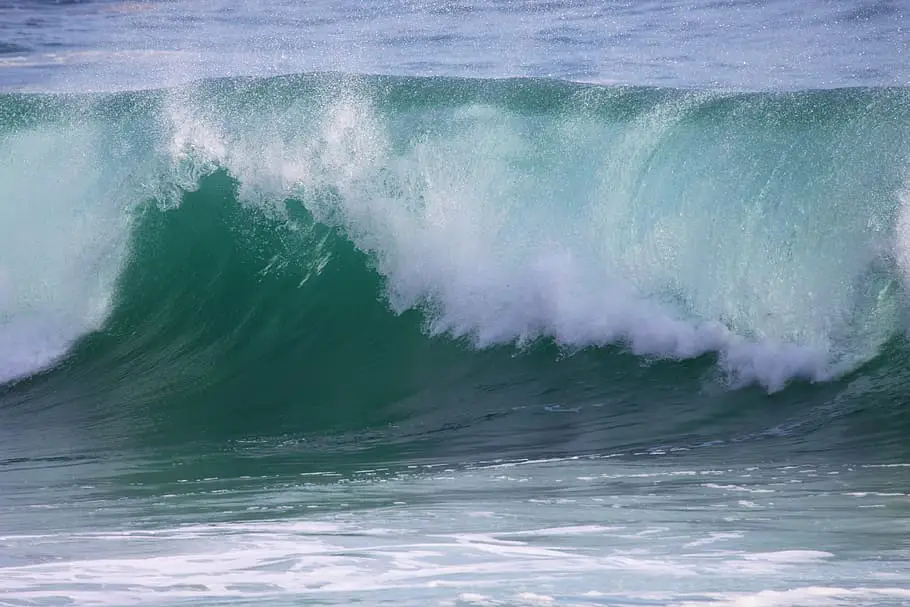
Waves that break right on the shoreline are known as “shoreys” or a “shore break.” These waves can pack a punch, crashing hard on the sand and making it a real challenge for surfers to push past. While they’re thrilling to watch, shoreys demand respect – they’re powerful and require skill to navigate!
14. The back
“The back” is the calm area beyond the breaking waves, where surfers wait in what’s called the line up. This is where you’ll be ready to catch waves after you’ve learned to navigate the waves closer to shore and mastered moves like the duck dive to get through them. It’s where the real surfing action happens!
15. Lineup
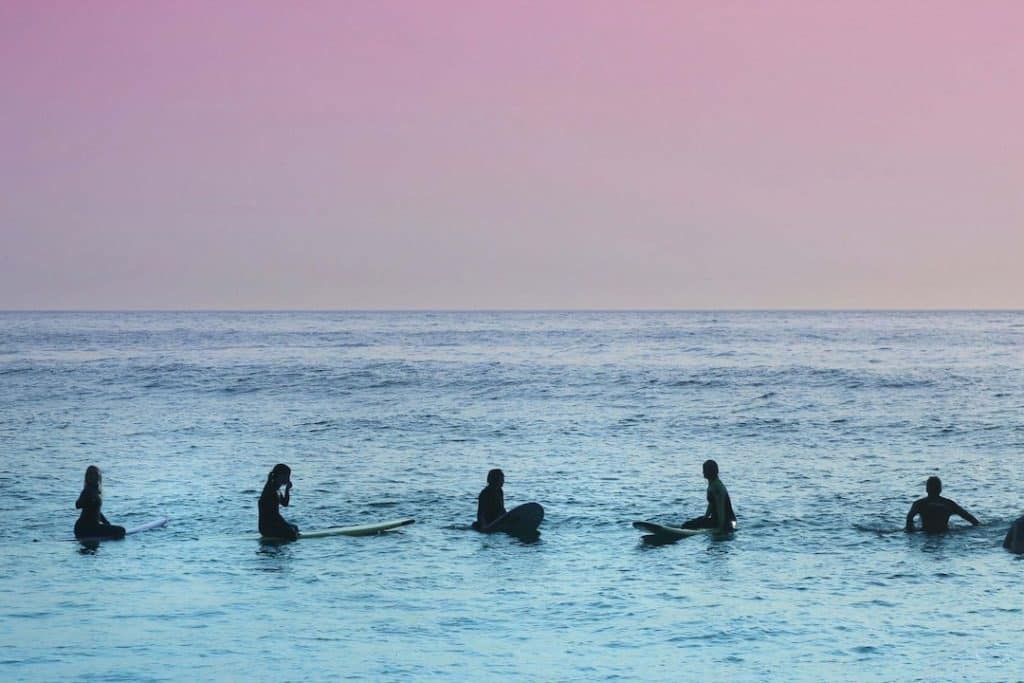
We briefly alluded to the “line up” above, but let’s quickly clarify what we mean by this surfer slang:
The “line up” is where the magic happens—it’s the spot out beyond the breaking waves where local surfers and visitors alike gather, waiting for the perfect set to roll in.
Within the line up, you’ll find the “takeoff zone,” the prime spot along the surf line where waves start to break. Surfers position themselves for catching waves right as they peak, giving them the perfect moment to “take off” and initiate turns as they ride the wave’s energy. This zone is all about timing and positioning to catch the wave at its most powerful.
16. Set Waves
Set waves are powerful waves that come in groups of two or more, often arriving as two consecutive wave crests. These are the most sought-after waves in any swell because they deliver more power and longer, thrilling rides.
17. Twinny
In surf slang, this refers to the iconic twin-fin surfboard. Originally introduced in the 1940s, it wasn’t until decades later that Californians began fine-tuning its design, giving it a unique style and feel.
Over time, though, the twin fin was overshadowed by the thruster, which is now the go-to setup for performance.
That said, today, the twin fin is making a comeback as a novelty setup, loved for its retro vibe and smooth, stylish rides rather than for hardcore performance.
18. Barrelling Waves
A barrelling wave is a special type of wave where the water curls over itself, creating a hollow, tube-like shape in the middle. Imagine the wave as a rolling sheet of water. As it builds up and reaches its peak, the top part, known as the “lip,” pitches forward and curves down in front of the wave’s base, forming an open tunnel.
For surfers, this “barrel” is the dream spot to ride inside, as they can surf through the hollow section, which feels like being inside a moving tunnel made of water.
19. Getting barrelled
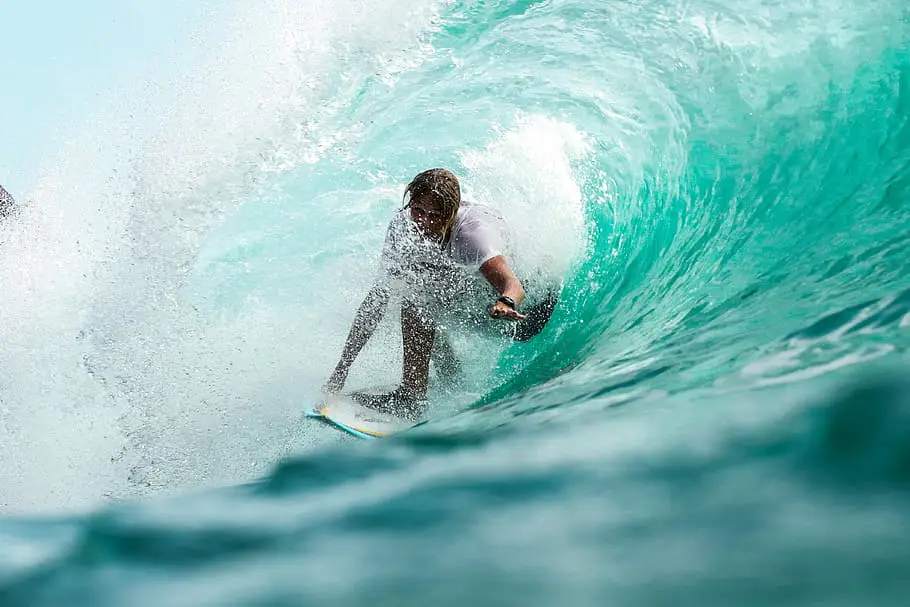
When surfers find themselves inside the hollow tube of a barrelling wave, they’re “getting barrelled”—the holy grail of surfing experiences. Many wave riders chase this feeling with unmatched passion, dedicating their entire lives to catching that perfect barrel. You’ll also hear surfers call it getting “pitted,” “tubed,” “slotted,” “the green room,” or even “kegged” when they’re in the zone, riding the ultimate wave.
20. Indo
You guessed it right: Indo refers to Indonesia, one of the world’s best learn-to-surf destinations. With a fantastic climate and epic waves suitable for all skill levels, a low cost of living, and some great entertainment and dining options, it’s certainly worth a visit!
21. Ragdolled
The next level beyond a simple wipeout is getting “ragdolled.” This happens when, after falling off, a powerful wave grabs hold and tosses you around underwater, leaving you completely at its mercy. The term comes from the fact that, just like a ragdoll, you have zero control over your arms and legs as you’re spun by the force of the water.
22. Whitewash
In surfing, “whitewash” refers to the foamy, broken part left behind when waves break. This is where most beginners start paddling, as whitewash has a gentler energy compared to the powerful, unbroken wave face. It’s the perfect playground for new surfers to get comfortable and build their skills.
23. Wettie

A “wettie” is surf slang for a wetsuit. Wetsuits are made from neoprene, a flexible, insulating material that keeps surfers warm in colder water. They come in various thicknesses—usually ranging from 2mm to 6mm—designed to provide warmth depending on the water temperature.
24. Bommie
“Bommie” is surf slang for a bombora—an Aboriginal term for a submerged rock or reef shelf located farther out from shore. When waves break over these underwater formations, called a reef break, they can create massive, powerful waves.
25. Backhand/Forehand
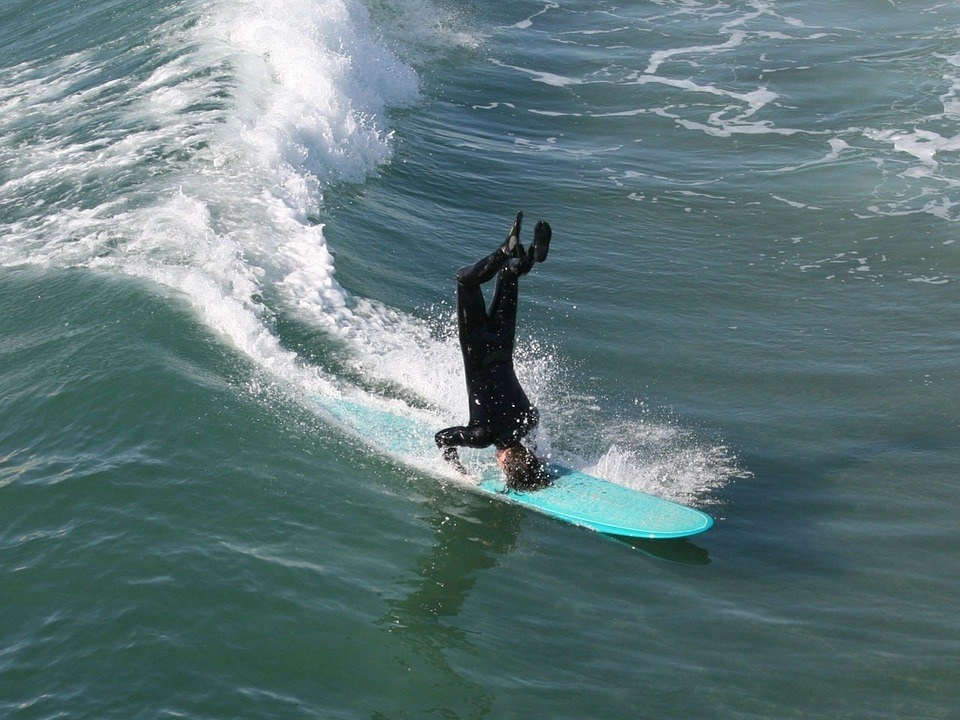
In surfing, “backhand” and “forehand” describe your body’s position relative to the wave. If you’re facing the wave, you’re surfing forehand; if your back is to the wave, you’re surfing backhand.
For example, a goofy-footed surfer (someone who surfs with their right foot forward) rides forehand on a left-breaking wave.
These terms help surfers understand their stance and approach to different waves.
26. Nica
“Nica” is short for Nicaragua, a dream destination for surfers seeking warm waters, consistent waves, and breathtaking tropical scenery. It’s one of the incredible tropical spots where Rapture Surfcamps has set up camp, offering surfers the chance to explore Nicaragua’s famous breaks, chill beach vibes, and untouched coastline.
27. Closeout
A “closeout” happens when a wave breaks all at once in a straight line rather than peeling in rideable sections. These waves are unrideable, as they don’t offer a wall to surf along, making it tough for surfers to catch a good wave.
28. Pura Vida

An important cultural lifestyle, Pura Vida is a concept in Costa Rican culture that’s become a way of life. It’s hard to define, but locals believe it to be an attitude, an emotion, and a feeling of contentment all rolled into one. If you really want to know what it is, you could always join our Costa Rica surf camp and experience it firsthand.
29. Quiver
A “quiver” is a surfer’s collection of boards, each tailored for different wave conditions. Many pros have quivers packed with dozens—or even hundreds—of boards to suit every surf scenario
30. Stoked
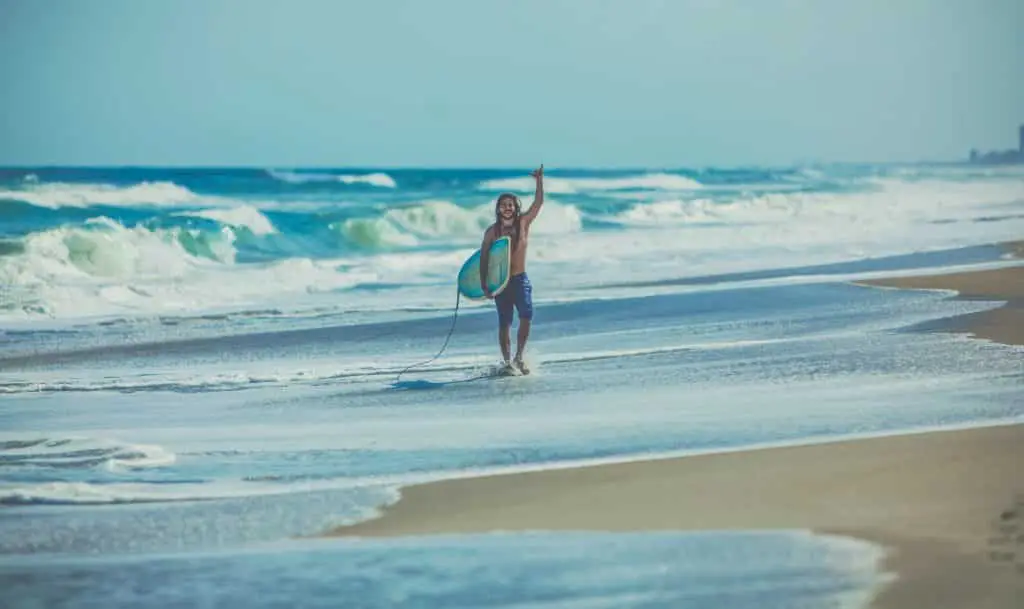
The feeling of being excited and happy to the point that you cannot contain yourself. Similar to being amped or hyped up. John John Florence’s favorite word and a cornerstone phrase if you want to speak like a surfer.
31. Mal/Malibu
No, “mal” isn’t a place—it’s surf slang for a longboard! Typically ranging from 9 to 11 feet, a mal is super buoyant with forgiving rails, making it an ideal choice for beginner surfers. Its size and stability allow for easier balance and smoother rides. Mals come in various styles, from soft tops to timber, fiberglass, and epoxy builds, offering something for every skill level and style.
32. Shoulder
The “shoulder” of a breaking wave is the section just outside the powerful pocket, along the wave face, where the energy softens.
This area offers more room for riding waves with lateral maneuvers, allowing surfers to carve out smooth turns without the intensity found in the wave’s core as the wave breaks.
33. Drop-in
A “Drop-in” is a big no-no in surf culture! It’s when one surfer takes off on a wave that another surfer is already riding, cutting them off mid-ride. Whether it’s accidental or intentional, dropping in is risky and can stir up serious tension in the water. Respecting the line up and avoiding drop-ins is key to keeping the surf vibe friendly and safe for everyone.
34. Surfer’s froth
That feeling every beginner surfer gets when they’re ready to take their skills to the next level. Can also be used as a verb e.g. “I’m frothing to try my new board at a Rapture surf camp in Bali“.
35. Boggings
“Boggings” happens when a surfer’s weight shifts too far back so that the surfboard nose lifts. When this occurs, the board slows down, making it tough to keep momentum. Mastering weight distribution and maintaining nose control—or even trying some surfboard nose riding—helps prevent bogging and keeps the ride smooth and balanced.
36. Dawny
A “dawny” is when surfers go on dawn patrol, hitting the water at first light to catch waves as the sun begins to rise. There’s something magical about a dawny session—the water is calm, the beach is quiet, and the waves are often glassy and untouched.
37. Off The Hook
When surfers say the waves are “off the hook,” they’re describing those dream days when the waves break perfectly, creating surfable waves that are powerful, consistent, and flawless.
38. Swell Period
The “swell period” is the time it takes for the crests of two waves within an incoming wave train to pass a specific point.
This timing, also called the wave interval, is influenced by the energy of waves generated far out at sea and plays a huge role in determining wave quality at any surf spot.
For example, a longer swell period typically means more powerful, better-shaped waves, making it essential knowledge for planning an epic surf session.
39. No Man’s Land
“No Man’s Land” is the tough spot where surfers find themselves trapped between the shoreline and a series of oncoming, breaking waves. This position makes paddling back out to the line up extremely difficult. When caught here, surfers usually have to wait for a lull between the larger waves before they can attempt to slip back into clear water. This challenging zone is also known as “Caught Inside,” “White Zone,” or “Crash Zone.”
40. Double-up Wave
A double-up wave, also called a “Humpback,” forms when two separate waves combine, creating a single wave with intense, amplified energy. This powerful wave is often larger and more forceful than typical waves, making it a thrilling yet challenging ride for surfers.
41. The Turtle Roll
A turtle roll is a lifesaver for longboard surfers facing a breaking wave head-on! When paddling out, longboards can’t duck dive because of their buoyancy. So, surfers use the turtle roll: they flip themselves and their board upside down, gripping the rails firmly as the wave crashes overhead. This technique lets the wave pass without knocking them back, so they keep their momentum toward the lineup without getting pushed to shore.
42. Messy Waves
Messy waves are waves that break irregularly and lack a clean, well-defined shape, often caused by onshore wind blowing from the ocean toward the shore. These winds create choppy, turbulent water with waves that break unpredictably, making it challenging for surfers to find a smooth ride.
43. Goofy Foot
In surfing, a “goofy foot” refers to a stance where the surfer rides with their right foot forward and their left foot back on the board.
This stance is opposite to the more common “regular foot” stance, where surfers position themselves with their left foot forward.
44. Ten Toes
“Ten toes” in surfing refers to a maneuver where a surfer walks to the very front of a longboard and places all ten toes over the nose of the board, also known as “hanging ten.” This classic move is a hallmark of traditional longboarding, showcasing the surfer’s balance and style as they glide on the nose of the board while the wave rolls beneath them.
45. Beach Break
A beach break is a type of surf break where waves break over a sandy seabed, as opposed to rock or coral reefs. The sandbars along the shore shape and influence the waves, causing them to break in various spots depending on the tides, swell, and wind.
Beach breaks are often beginner-friendly because the sandy bottom is more forgiving than reefs, but they can also produce powerful and hollow waves, making them a favorite for surfers of all levels.
46. Wave Strikes
Wave strikes occur when a wave hits or impacts a surfer or their board with significant force. This can happen during wipeouts, closeouts, or while attempting maneuvers in heavy surf.
47. Paddle Battle
A paddle battle in surfing is a situation where two or more surfers paddle fiercely to reach the same wave first. This often happens in crowded lineups or competitive surfing environments, as each surfer wants the “right of way” to catch and ride the wave.
The surfer who reaches the peak first typically has priority, but a paddle battle can be intense, requiring stamina and strong paddling skills. It can also lead to tensions if one surfer feels another is being overly aggressive or breaking surf etiquette by competing for the wave.
Free Phone Callback.
Free Online Meeting.
We understand how important holidays are.
We are offering free Phone Callbacks or online face to face meetings for you.
Choose one of our available customer happiness agents below and start your Rapturecamps Journey.
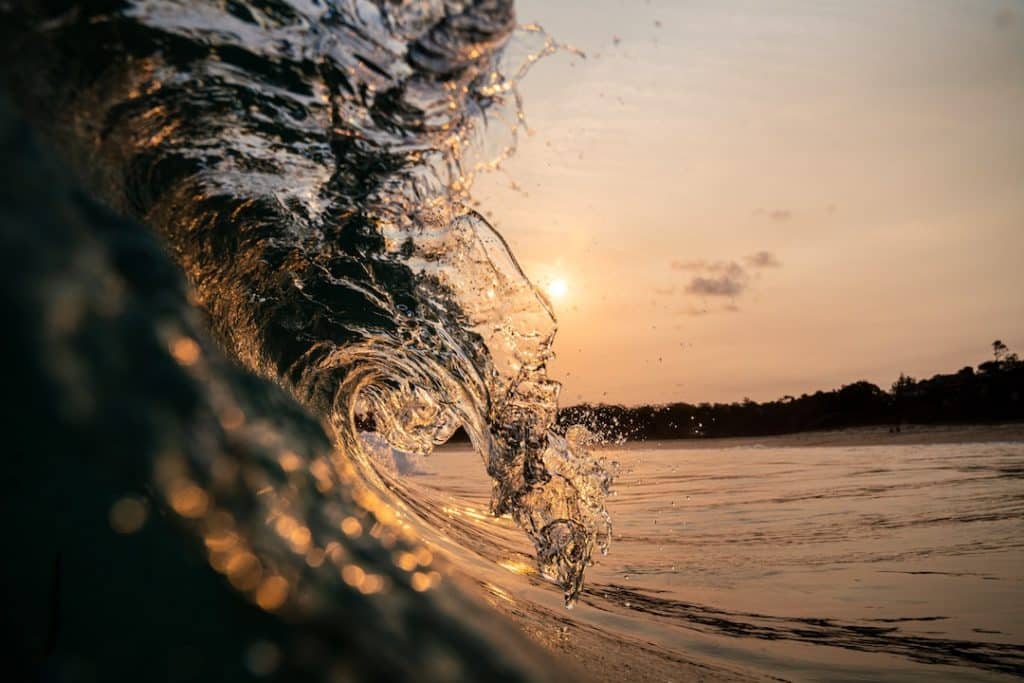
Ready for a surf trip? SURF LIKE A PRO
Take your skills to the next level with Rapturecamps
We provide excellent surf and Yoga vacations in Bali, Portugal, Nicaragua and Costa Rica. Catch your next wave with Rapturecamps!
